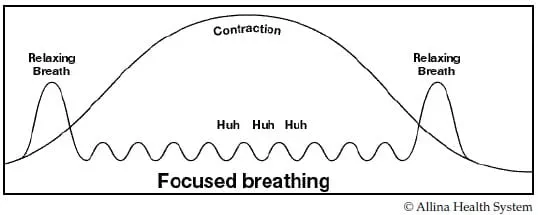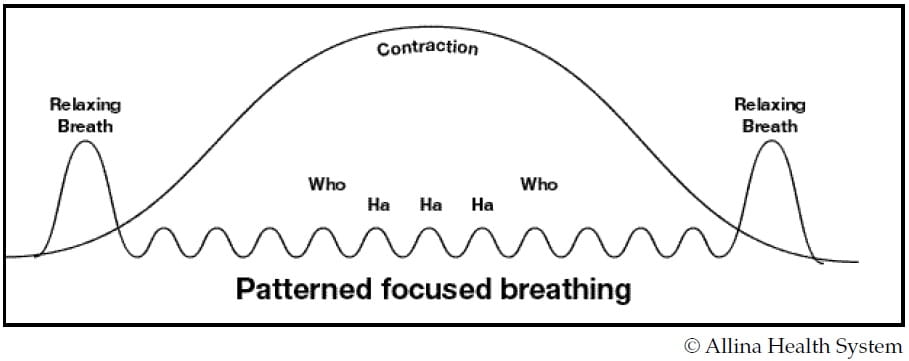
Breathing to distract
Focused breathing
As your contractions get stronger, you may find it easier to breathe lightly. This means moving your breathing up to chest level. This is the kind of breathing you do when you talk. 
You may also want to focus on your breathing rather than on the discomfort of the contraction. It is important to keep this kind of breathing even and easy.
To find the balance of rate and depth that is best for you:
- Place your hands lightly on your chest, above your breasts.
- Breathe lightly and evenly. You may feel a slight movement with each breath.
- Set a steady, regular rhythm for yourself. For example, try to inhale for three counts and exhale for three counts: "In-2-3, Out-2-3."
- When you exhale, whisper "huh."
- To help keep an even rhythm, try counting or repeating words like "In-Out, In-Out." If you say them only in your head, whisper "huh" on the exhale. If you say the words out loud, the words will take the place of "huh."
- Use this technique during a contraction when relaxing breathing isn't enough to keep you comfortable.
- Continue to use your relaxing breath for the start and end of the contraction.
Patterned focused breathing
For even more distraction, you might want to add a pattern of sound to your exhales. For example, try "Ha, Ha, Ha, Who" or "Come, Out, Ba-By."

Practicing your focused breathing for labor
In order for focused breathing to be useful in labor, you need to be able to do it for at least a minute. This is how long most contractions last in active labor. At the end of the minute you should not feel breathless or dizzy. Practicing the two kinds of focused breathing while you are pregnant will make them easier to do in labor.
If you practice your breathing alone:
- Use a clock with a second hand to time the minute.
- As the minute begins, take your relaxing breath and then begin your focused breathing.
- Imagine the contraction getting stronger and stronger for 20 seconds.
- At this point the contraction is at its peak or strongest part.
- After about 25 seconds at the peak, the contraction begins to ease.
- By the time a minute has passed the contraction is over. Take a relaxing breath.
- Rest for one minute breathing normally. Then, start the next practice contraction.
Do a series of three contractions with one minute of rest between each of them. If your breathing is comfortable at the end of this five-minute cycle, you have found the level and rate that is best for you. If your breathing is not comfortable, try breathing a little slower during the contractions or changing your pattern.
Practice will give you confidence in your ability to use breathing as a comfort tool. You may find in labor that you start doing a completely different type of breathing or pattern. If it works, do it!
If you practice your breathing with your partner or labor companion:
- Have that person call the contraction. This means telling you when the contraction begins, is growing stronger, at the peak, easing and is over.
- You can try different things that person might do to help you:
- Tell you when 30 to 45 seconds have passed.
- Count or say the rhythm with you.
- Give you encouragement.
- Help you stay relaxed by touching a part of your body that is likely to tense, like your shoulders or back.
Mother baby care
A wide variety of videos on topics ranging from labor and delivery to newborn and postpartum care can be found on our Allina Health mother baby care video page.
Giving birth: Managing pain
- Cesarean birth (five video topics)
- Vaginal birth (five video topics)
Breastfeeding
Breastfeeding your baby is available in English, Arabic, Hmong, Russian, Somali and Spanish.